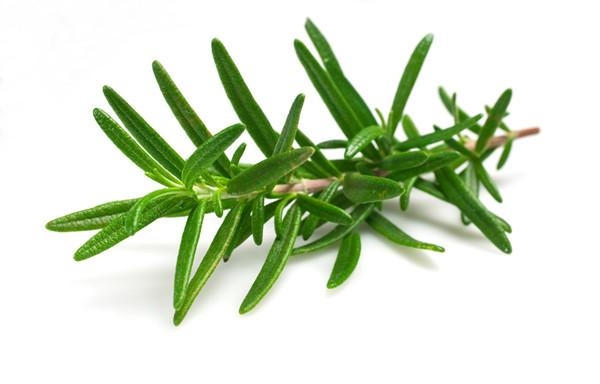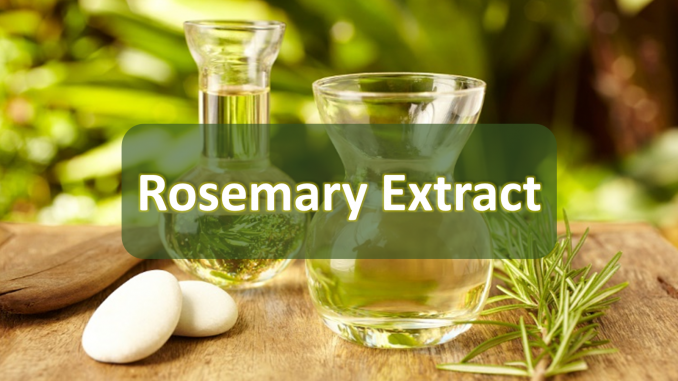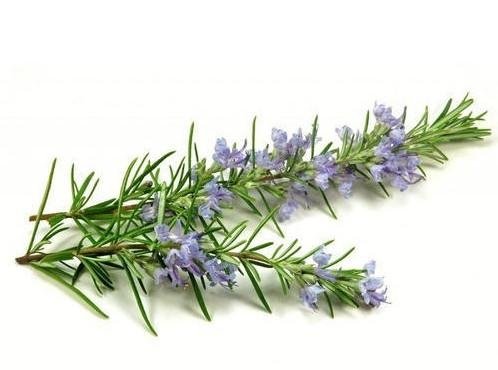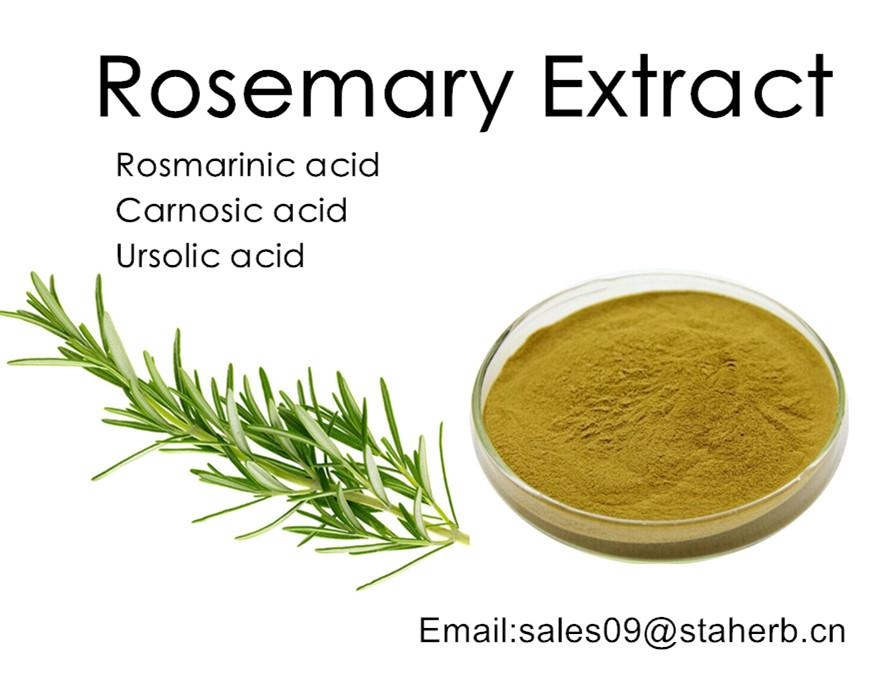
迷迭香提取物
品名: 迷迭香提取物
拉丁名: Rosmarinus officinalis
顏色: 淺黃色至黃綠色精細粉末
規格: 鼠尾草酸:1%-95%,油溶
熊果酸:5%-98%,HPLC,油溶
迷迭香酸:2.5%-98%,水溶
迷迭香精油:100%
比例: 5:1,10:1,20:1 TLC.
檢測方式: HPLC / TCL

迷迭香提取物的功效
1.天然抗氧化劑,廣氾應用於食品、功能性食品、調味品、調味品、日用化工等行業;
2.抗衰老作用。它能清除體內過量產生的自由基,消滅單線態氧,保護細胞膜結構,延緩衰老過程;
3.減肥效果強。它可以通過抗氧化劑的作用刺激和加速脂肪的代謝。它不僅能降低血壓,還能促進糞便中的脂類化合物排出,從而達到減肥的目的;
4.具有 作用,可用於治療心血管疾病。
迷迭香提取物的應用
1.作為天然抗氧化劑,其抗氧化活性高于VE。廣氾應用於化妝品、食品、香料、香水、沐浴露、洗發水、香皂、空氣清新劑等。
2.迷迭香提取物作為一個 的神經和大腦補充劑,提高記憶技能和注意力。迷迭香油濃烈的花香使人放鬆,對神經系統有刺激作用。它刺激大腦和中樞神經系統,對抗精神疲勞,從而提高精神清晰度。它是治療抑鬱、無聊、疲勞和健忘的良藥。
3.它能保護腦細胞免受衰老過程的影響,增強記憶力。
4.眾所週知,迷迭香提取物能保護皮膚細胞,防止皺紋和黑斑形成等與年齡有關的皮膚變化,保護皮膚細胞免受老化造成的損害,從而延緩皺紋和皮膚下垂的發生。


References參考文獻:
- 1.
Vidak M, Rozman D, Komel R. Effects of flavonoids from food and dietary supplements on glial and Glioblastoma Multiforme cells. Mol Ther. 2015 Oct 23;20(10):19406–32.
- 2.
Li Y, Go VL, Sarkar FH. The role of Nutraceuticals in pancreatic cancer prevention and therapy: targeting cellular signaling, MicroRNAs, and Epigenome. Pancreas. 2015 Jan;44(1):1–10.
- 3.
Niedzwiecki A, Roomi MW, Kalinovsky T, Rath M. Anticancer Efficacy of Polyphenols and Their Combinations. Nutrients. 2016 Sep 9;8(9). pii: E552.
- 4.
Newman DJ, Cragg GM, Snader KM. The influence of natural products upon drug discovery. Nat Prod Rep. 2000 Jun;17(3):215–34.
- 5.
Gilbert B, Alves LF. Synergy in plant medicines. Curr Med Chem. 2003 Jan;10(1):13–20.
- 6.
González-Vallinas M, González-Castejón M, Rodríguez-Casado A, Ramírez de Molina A. Dietary phytochemicals in cancer prevention and therapy: a complementary approach with promising perspectives. Nutr Rev. 2013;71:585–99.
- 7.
Helmerick EC, Loftus JP, Wakshlag JJ. The effects of baicalein on canine osteosarcoma cell proliferation and death. Vet Comp Oncol. 2014;12:299–309.
- 8.
Wakshlag JJ, Balkman CE. Effects of lycopene on proliferation and death of canine osteosarcoma cells. Am J Vet Res. 2010;71:1362–70.
- 9.
Wakshlag JJ, Balkman CA, Morgan SK, McEntee MC. Evaluation of the protective effects of all-trans-astaxanthin on canine osteosarcoma cell lines. Am J Vet Res. 2010;71:89–96.
- 10.
Kelsey JL, Moore AS, Glickman LT. Epidemiologic studies of risk factors for cancer in pet dogs. Epidemiol Rev. 1998;20:2014–7.
- 11.
Levine CB, Bayle J, Biourge V, Wakshlag JJ. Effects and synergy of feed ingredients on canine neoplastic cell proliferation. BMC Vet Res. 2016 Aug 2;12(1):159.
- 12.
Sharma RA, McLelland HR, Hill KA, Ireson CR, Euden SA, Manson MM, et al. Pharmacodynamic and pharmacokinetic study of oral curcuma extract in patients with colorectal cancer. Clin Cancer Res. 2001;7:1894–900.
- 13.
Lee WH, Loo CY, Young PM, Traini D, Mason RS, Rohanizadeh R. Recent advances in curcumin nanoformulation for cancer therapy. Expert Opin Drug Deliv. 2014 Aug;11(8):1183–201.
- 14.
Douglass BJ, Clouatre DL. Beyond yellow curry: assessing commercial Curcumin absorption technologies. J Am Coll Nutr. 2015;34(4):347–58.
- 15.
Berginc K, Trontelj J, Basnet NS, Kristl A. Physiological barriers to the oral delivery of curcumin. Pharmazie. 2012 Jun;67(6):518–24.
- 16.
Shaikh J, Ankola DD, Beniwal V, Singh D, Kumar MN. Nanoparticle encapsulation improves oral bioavailability of curcumin by at least 9-fold when compared to curcumin administered with piperine as absorption enhancer. Eur J Pharm Sci. 2009 Jun 28;37(3–4):223–30.
- 17.
Pesakhov S, Khanin M, Studzinski GP, Danilenko M. Distinct combinatorial effects of the plant polyphenols curcumin, carnosic acid, and silibinin on proliferation and apoptosis in acute myeloid leukemia cells. Nutr Cancer. 2010;62:811–24.
- 18.
Einbond LS, HA W, Kashiwazaki R, He K, Roller M, Su T, et al. Carnosic acid inhibits the growth of ER-negative human breast cancer cells and synergizes with curcumin. Fitoterapia. 2012;83:1160–8.
- 19.
Passos JF, Miwa S, von Zglinicki T. Measuring reactive oxygen species in senescent cells. Methods Mol Biol. 2013;965:253–63.
- 20.
Kunwar A, Barik A, Mishra B, Rathinasamy K, Pandey R, Priyadarsini KI. Quantitative cellular uptake, localization and cytotoxicity of curcumin in normal and tumor cells. Biochim Biophys Acta. 2008 Apr;1780(4):673–9.
- 21.
Rasband, WS. ImageJ. U.S. National Institutes of Health, Bethesda, Maryland, USA. 1997-2016.
- 22.
Wakshlag JJ, Kallfelz FA, Wakshlag RR, Davenport GM. The effects of branched-chain amino acids on canine neoplastic cell proliferation and death. J Nutr. 2006 July;136(7 Suppl):2007S–10S.
- 23.
Ramos S. Effects of dietary flavonoids on apoptotic pathways related to cancer chemoprevention. J Nutr Biochem. 2007 Jul;18(7):427–42.
- 24.
Ravindran J, Prasad S, Aggarwal BB. Curcumin and cancer cells: how many ways can curry kill tumor cells selectively? AAPS J. 2009 Sep;11(3):495–510.
- 25.
Plouzek CA, Ciolino HP, Clarke R, Yeh GC. Inhibition of P-glycoprotein activity and reversal of multidrug resistance in vitro by rosemary extract. Eur J Cancer. 1999 Oct;35(10):1541–5.
- 26.
Chen J, Li L, Su J, Li B, Zhang X, Chen T. Proteomic analysis of G2/M arrest triggered by natural Borneol/Curcumin in HepG2 cells, the importance of the reactive oxygen species-p53 pathway. J Agric Food Chem. 2015 Jul 22;63(28):6440–9.
- 27.
Lim TG, Lee SY, Huang Z, Lim DY, Chen H, Jung SK, et al. Curcumin suppresses proliferation of colon cancer cells by targeting CDK2. Cancer Prev Res (Phila). 2014 Apr;7(4):466–74.
- 28.
Baharuddin P, Satar N, Fakiruddin KS, Zakaria N, Lim MN, Yusoff NM, et al. Curcumin improves the efficacy of cisplatin by targeting cancer stem-like cells through p21 and cyclin D1-mediated tumour cell inhibition in non-small cell lung cancer cell lines. Oncol Rep. 2016 Jan;35(1):13–25.
- 29.
Kumar D, Basu S, Parija L, Rout D, Manna S, Dandapat J, Debata PR. Curcumin and Ellagic acid synergistically induce ROS generation, DNA damage, p53 accumulation and apoptosis in HeLa cervical carcinoma cells. Biomed Pharmacother. 2016 July;81:31–7.
- 30.
Mosieniak G, Sliwinska MA, Przybylska D, Grabowska W, Sunderland P, Bielak-Zmijewska A, Sikora E. Curcumin-treated cancer cells show mitotic disturbances leading to growth arrest and induction of senescence phenotype. Int J Biochem Cell Biol. 2016 May;74:33–43.
- 31.
Tong L, Chuang CC, Wu S, Zuo L. Reactive oxygen species in redox cancer therapy. Cancer Lett. 2015 Oct 10;367(1):18–25.
- 32.
Deng Y, Verron E, Rohanizadeh R. Molecular mechanisms of anti-metastatic activity of Curcumin. Anticancer Res. 2016 Nov;36(11):5639–47.
- 33.
Shehzad A, Lee YS. Molecular mechanisms of curcumin action: signal transduction. Biofactors. 2013 Jan-Feb;39(1):27–36.
- 34.
Khuda-Bukhsh AR, Das S, Saha SK. Molecular approaches toward targeted cancer prevention with some food plants and their products: inflammatory and other signal pathways. Nutr Cancer. 2014;66(2):194–205.
- 35.
Moore J, Yousef M, Tsiani E. Anticancer Effects of Rosemary (Rosmarinus officinalis L.) Extract and Rosemary Extract Polyphenols. Nutrients. 2016 Nov 17;8(11). pii: E731.
- 36.
Tai J, Cheung S, Wu M, Hasman D. Antiproliferation effect of rosemary (Rosmarinus Officinalis) on human ovarian cancer cells in vitro. Phytomedicine. 2012;19:436–43.
- 37.
Tsai CW, Lin CY, Lin HH, Chen JH. Carnosic acid, a rosemary phenolic compound, induces apoptosis through reactive oxygen species-mediated p38 activation in human neuroblastoma IMR-32 cells. Neurochem Res. 2011;36:2442–51.
- 38.
Fossey SL, Bear MD, Lin J, Li C, Schwartz EB, Li PK, et al. The novel curcumin analog FLLL32 decreases STAT3 DNA binding activity and expression, and induces apoptosis in osteosarcoma cell lines. BMC Cancer. 2011 Mar 28;11:112.
- 39.
Verheij M, Ruiter GA, Zerp SF, van Blitterswijk WJ, Fuks Z, Haimovitz-Friedman A, Bartelink H. Role of the stress-activated protein kinase (SAPK/JNK) signaling pathway in radiation-induced apoptosis. Radiother Oncol. 1998 Jun;47(3):225–32.
- 40.
Cul J, Zhang M, Zhang YQ, JNK XZH. Pathway: diseases and therapeutic potential. Acta Pharmacol Sin. 2007 May;28(5):601–8.
- 41.
Bogoyevitch MA, Ngoei KR, Zhao TT, Yeap YY, Ng DC. CpJun N-terminal kinase (JNK) signaling: recent advances and challenges. Biochim Biophys Acta. 2010 Mar;1804(3):463–75.
- 42.
Basu S, Kolesnick R. Stress signals for apoptosis: ceramide and c-Jun kinase. Oncogene. 1998 Dec 24;17(25):3277–85.
- 43.
Johnson CR, Jiffar T, Fischer UM, Ruvolo PP, Jarvis WD. Requirement for SAPK-Jnk signaling in the induction of apoptosis by ribosomal stress in REH lymphoid leukemia cells. Leukemia. 2003 Nov;17(11):2140–8.
- 44.
Ventura JJ, Hübner A, Zhang C, Flavell RA, Shokat KM, Davis RJ. Chemical genetic analysis of the time course of signal transduction by JNK. Mol Cell. 2006 Mar 3;21(5):701–10.
- 45.
Li J, Xiang S, Zhang Q, Wu J, Tang Q, Zhou J, et al. Combination of curcumin and bicalutamide enhanced the growth inhibition of androgen-independent prostate cancer cells through SAPK/JNK and MEK/ERK1/2-mediated targeting of NF-κB/p65 and MUC1-C. J Exp Clin Cancer Res. 2015 May 15;34:46.
- 46.
Kuwabara M, Takahashi K, Inanami O. Induction of apoptosis through the activation of SAPK/JNK followed by the expression of death receptor Fas in X-irradiated cells. J Radiat Res. 2003 Sep;44(3):2013–9.
- 47.
Davies C, Tournier C. Exploring the function of the JNK (c-Jun N-terminal kinase) signaling pathway in physiological and pathological processes to design novel therapeutic strategies. Biochem Soc Trans. 2012 Feb;40(1):85–9.
- 48.
Kim J, Freeman MRJNK. SAPK mediates doxorubicin-induced differentiation and apoptosis in MCF-7 breast cancer cells. Breast Cancer Res Treat. 2003 Jun;79(3):321–8.
- 49.
Lee LF, Li G, Templet